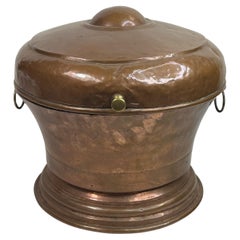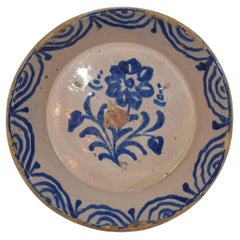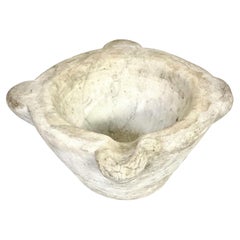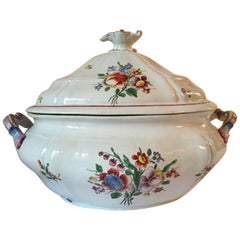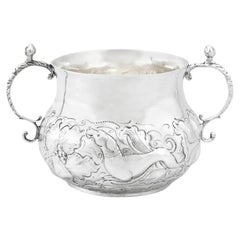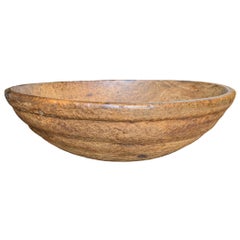18th Century and Earlier Serving Bowls
to
12
66
66
266
1,373
403
266
639
251
58
22
45
57
47
94
132
88
46
20
16
5
3
3
1
1
1
1
36
21
20
15
10
44
21
45
23
22
10
10
66
66
66
3
2
1
1
1
Period: 18th Century and Earlier
18th Century German Hammered Copper & Brass Bread Box, Kitchen Utensil
Located in Nuernberg, DE
Beautiful antique 18th century German bread box. Perfect for decoration in your old country kitchen. The piece is in good used antique condition with patina and a view minor dents. S...
Category
German Biedermeier Antique 18th Century and Earlier Serving Bowls
Materials
Brass, Copper
18th/ 19th Century Spanish Glazed Terracotta Bowl
Located in Buisson, FR
Beautiful weathered piece of pottery from the South of Spain. Amazing blue decoration
Spain circa 1750-1850
Good but weathered condition
Category
Spanish Rustic Antique 18th Century and Earlier Serving Bowls
Materials
Terracotta
$553 Sale Price
53% Off
18th Century Heavy Marble Mortar
Located in LA CIOTAT, FR
A heavy and nicely textured mortar fashioned from Carrara marble, and originally used as an apothecary's tool, or as a pounding vessel in an 18th century kitchen...
Category
French Antique 18th Century and Earlier Serving Bowls
Materials
Marble, Carrara Marble
Italy Late 18th Century Porcelain Richard Ginori Doccia Soup Bowl
Located in Brescia, IT
This very fine soup bowl is a piece of the production of the Italian factory Richard Ginori Doccia.
It is a timeless piece rich of beauty and elegance, ...
Category
Italian Baroque Antique 18th Century and Earlier Serving Bowls
Materials
Porcelain
Antique Sterling Silver Porringer
Located in Jesmond, Newcastle Upon Tyne
An exceptional, fine and impressive antique Charles II English sterling silver porringer; part of our collectable silverware collection.
This exceptional antique Charles II sterling silver porringer has a circular rounded form onto a collet base.
The surface of the porringer is embellished with an impressive chased hunting hound to one side and a stag to the other, all amidst large foliate designs and incorporating pinstruck swirl designs.
This English silver porringer is fitted with two impressive cast, leaf decorated S-scroll handles with elevated figural shaped thumbpieces.
Note: After surviving the Great Fire of London the records at the London Assay office were destroyed by fire in 1681; their catalogues and documentation began again in 1697. Due to this unfortunate event we are unable to associate a maker to this porringer.
Condition
This antique silver porringer...
Category
English Charles II Antique 18th Century and Earlier Serving Bowls
Materials
Sterling Silver
18th Century Early American Ash Burl Bowl
Located in Chicago, IL
An incredible 18th century early American ash burl bowl from New England, possibly New York, with a heavy lip, spiral-cut ribbed sides, and an unbel...
Category
American American Colonial Antique 18th Century and Earlier Serving Bowls
Materials
Ash, Burl
Antique 18th Century English Georgian William Wright Pewter Porringer Bowl
By William Wright
Located in Dayton, OH
Late 18th Century Antique English Georgian pewter porringer soup or stew bowl, dish or cup with crown handle / ear by William Wright of Little Minorie...
Category
Georgian Antique 18th Century and Earlier Serving Bowls
Materials
Pewter
$176 Sale Price
25% Off
Pair of Rare Danish Eighteenth-Century Silver Soup Tureens with Trays
Located in London, GB
Pair of rare Danish eighteenth-century silver soup tureens with trays
Danish, 1750
Tureens: height 27cm, width 33cm, depth 20cm
Trays: height 6cm, width 45cm, depth 28cm
The su...
Category
Danish Antique 18th Century and Earlier Serving Bowls
Materials
Silver
Italy Late 18th Century Richard Ginori Porcelain Soup Bowl with Floral Decor
Located in Brescia, IT
This is a soup bowl in a smaller size as usual, it was a special sized for fine foods. This is a piece of the production of the Italian factory Richard Ginori Doccia...
Category
Italian Baroque Antique 18th Century and Earlier Serving Bowls
Materials
Porcelain
Georgian Sterling Silver Footed Two-Handled "Sweetmeats" Dish
By Thomas Daniell 2
Located in New York, NY
Georgian, sterling silver, footed, two-handled "sweetmeats" dish with liner, London, 1784, Thos. Daniell - maker. Measures: 8" wide (from handle to handle;
5 1/2" wide not measuring...
Category
English George III Antique 18th Century and Earlier Serving Bowls
Rarity 17C small Chinese Porcelain ‘Hatcher Cargo’ blue and white Box Christies
Located in Amsterdam, Noord Holland
Size doesn't matter
Visible in the pictures is a very nice small box from the Hatcher Cargo.
Mid 17th century
Painted with chrysanthemum to the domed cover.
Provenance: This litt...
Category
Ming Antique 18th Century and Earlier Serving Bowls
Materials
Porcelain
Top Quality Wanli / Tianqi Antique Ming Period Chinese Porcelain Crane Waves
Located in Amsterdam, Noord Holland
Description
A very nicely potted and painted early 17th century dish of a desirable cobalt blue!
Stunning piece with unusal reverse decorated design. Visible are cranes, different k...
Category
Ming Antique 18th Century and Earlier Serving Bowls
Materials
Porcelain
$2,440 Sale Price
20% Off
Creamware Pottery Sailor's Farewell and Chinoiserie Punch Bowl
Located in Downingtown, PA
Creamware Pottery sailor's farewell punch bowl with Chinoiserie Scenes on Reverse,
Late 18th Century
The large polychrome creamware bowl has a scene to one side depicting a sailor's farewell. The officer, with a sword in a scabbard to his right hip, stands with arms crossed and his female companion looks away from him as she holds a parasol in her hand. In the background in a Royal Navy frigate at anchor and a sailor in a longboat rowing towards him.
To the reverse side is a charming chinoiserie scene of two women and a young boy watching...
Category
English Georgian Antique 18th Century and Earlier Serving Bowls
Materials
Creamware, Pottery
Antique Kangxi Amsterdam Bont Porcelain Bowl Chinese Polychrome Landscape
Located in Amsterdam, Noord Holland
A very nicely made 18th century Kangxi Amsterdam Bont porcelain bowl.
A very nicely made 18th century Kangxi Amsterdam Bont porcelain bowl.
We take a look at Amsterdams Bont porcelain from China. A relatively unknown niche of Chinese porcelain from ca 1680-1740 that was partly decorated in Europe. Because mainstream Chinese collectors have yet to discover the historical significance of these wares they are relatively easy to find in Holland. While also being highly interesting and of often super quality and with an amazing array of decorations. Amsterdams Bont is a name given to porcelain partly decorated in the Netherlands (most likely in cities like Delft, Haarlem, Makkum). Because Amsterdam was at this moment in time the trade centre of the western world and also of the porcelain trade a lot of this over enamelling was probably commissioned by Amsterdam merchants, to reap higher profits on otherwise boring Chinese wares. The name Amsterdam Bont probably derives from the fact that these type of decorated ware was sold by Amsterdam Merchants. Amsterdam Bont consists of either blanc or under glaze blue decorated Chinese porcelain of basic quality, that was later enhanced with red and sometimes other colours in the Netherlands. It must not be mistaken for other type of Chinese & Japanese blanc wares decorated in Europe. Those we simply call European Decorated Chinese porcelain...
Category
Chinese Qing Antique 18th Century and Earlier Serving Bowls
Materials
Porcelain
$504 Sale Price
20% Off
Antique pottery bowl from Kumamoto, Japan / Shodai ware / Edo / 18-19 thcentury
Located in Sammu-shi, Chiba
We have a unique Japanese aesthetic sense.
And only we can introduce unique items through our purchasing channels in Japan and the experience we have gained so far, in such a way that no one else can imitate.
It is speculated that this pottery was fired in the Shodai kiln in Kumamoto Prefecture during the Edo period, around the 18th century to the first half of the 19th century.
It is characterized by the use of iron-rich clay and the appearance of a white glaze that looks like falling snow.
As a feature, using clay with a lot of iron,
It is characterized by a white glaze that looks like snow.
This vessel is made with two types of glaze.
One is straw ash glaze and the other is rice husk ash glaze.
This rice husk ash glaze changes to a white glaze.
This pot is very beautiful with a petal-like rim.
However, there is one spot where the crack has been repaired.
The part marked with a red arrow has been broken once, but it seems to have been glued later.
Therefore, it will not leak even if you put water in it.
It's not very noticeable so I wouldn't worry about it.
This Shodai ware was made in Kumamoto Prefecture and was used there, so there are not many items in Japan.
It is a rare item.
Also, a wooden box is included, but it says "Karatsu ware...
Category
Japanese Edo Antique 18th Century and Earlier Serving Bowls
Materials
Pottery
Chinese Export Covered Bowl and Under-Plate, circa 1765
Located in New York, NY
A leaf molded bowl, cover and stand decorated with birds, insects and branches.
Measures: Diameter of plate 12".
Category
Antique 18th Century and Earlier Serving Bowls
Materials
Porcelain
Antique French Faience Lidded Bowl Tureen Hand Painted with Flowers and Insects
By Rouen
Located in Firenze, IT
A French 18th century large polychrome Faience lidded soup toureen or entree dish with scallop-shaped edges attributable to Rouen manufacture.
This lovely...
Category
French Rococo Antique 18th Century and Earlier Serving Bowls
Materials
Maiolica, Porcelain, Pottery, Faience
Antique Chinese Ming period Kraak Bowl Deer Wanli or Tianqi Period
Located in Amsterdam, Noord Holland
A very nicely decorated bowl Late 16th, early 17th century Ming period. Kraak scene with deer on outside and inside.
Delicate and beautiful piece.
Condition
Some chips/fritting ...
Category
Ming Antique 18th Century and Earlier Serving Bowls
Materials
Porcelain
$2,440 Sale Price
20% Off
Marble Mortar from 18th Century
Located in Marcq-en-Barœul, Hauts-de-France
This nice mortar is made of white marble. This is a French work from 18th Century
Category
French Louis XVI Antique 18th Century and Earlier Serving Bowls
Materials
Marble
Set of three Orange-Red Enameled Bowls by Kaj Franck for Finel, Finland, 1960s
By Kaj Franck, Finel
Located in Steenwijk, NL
A very nice set of three red-orange enameled bowls made by Kaj Franck for Finel, made in Finland in the 1960s. These bowls are in a very good condition with some signs of age and use...
Category
Finnish Mid-Century Modern Antique 18th Century and Earlier Serving Bowls
Materials
Enamel
Italy Richard Ginori Mid-18th Century Porcelain Hand Painted Tulip Decor Bowl
Located in Brescia, IT
Richard Ginori mid-18th century porcelain hand painted with Tulip Decor bowl.
This is a beautiful antique piece of this Italian production, handmade in 1...
Category
Italian Baroque Antique 18th Century and Earlier Serving Bowls
Materials
Porcelain
Antique Georgian 1780 Sterling Silver Sauceboats or Gravy Boats
By Matthew West
Located in Jesmond, Newcastle Upon Tyne
An exceptional, fine and impressive pair of antique George III Irish sterling silver sauceboats or gravy boats; an addition to our Georgian dining silverware collection.
These fine antique Georgian Irish sterling silver sauceboats have a plain oval rounded form.
The body of each gravy boat is embellished with impressive concave fluted decoration emanating from a central point of the underside, accented with graduating circular motifs to the terminals to the sides.
The rims of these impressive sauce boats are encompassed with a band of concave circular motifs.
The sauceboats are fitted with opposing scroll handles featuring chased stylized leaf design to the upper portion, incorporating a scrolling leaf decorated thumbpiece.
Each example of antique Georgian silverware is supported by three impressive applied hoof feet with stylized shell decorated sockets, accented with a sunburst design in junction with the body.
Pairs of Irish silver sauceboats in such exceptional condition are becoming increasingly difficult to locate.
Condition
These antique sauceboats are an exceptional gauge of silver for their type, exceptional quality and in exceptional condition. Full Irish hallmarks struck to the underside of each gravy boat are all very clear in keeping with age and location.
Dimensions
Length from back of handle to tip of lip 21.6cm/8.5".
Width 10.1cm/4".
Height 11.7cm/4.6".
Total Weight: 23.3 troy ounces/725g.
Maker: Matthew West...
Category
Great Britain (UK) George III Antique 18th Century and Earlier Serving Bowls
Materials
Silver, Sterling Silver
Marble Mortar from 18th Century
Located in Marcq-en-Barœul, Hauts-de-France
This nice mortar is made of white marble. This is a French work from 18th Century
Category
French Louis XVI Antique 18th Century and Earlier Serving Bowls
Materials
Marble
Circular Chinese Porcelain Bowl, Sung Period, 12th-14th Century
Located in Roma, IT
Chinese porcelain bowl adorned with cloud engravings.
12th-14th century, Sung period.
Category
Chinese Antique 18th Century and Earlier Serving Bowls
Materials
Porcelain
Collection of 4 Bronze Olas, Cooking Pots
Located in Round Top, TX
A wonderful collection of 18th century Olas - cooking pots from the Catalan region of Spain. Beautifully crafted from bronze. A stunning table top collection. The pieces range is siz...
Category
Spanish Antique 18th Century and Earlier Serving Bowls
Materials
Bronze
$4,200 / set
Worcester Pierced Porcelain Basket, Blue Scale Japanese Kakiemon, circa 1765
Located in London, GB
This is a rare and beautiful porcelain basket made by Worcester circa 1765 in their 1st or "Dr Wall" period. These baskets were used for dinners or desserts to serve fruit or bread. The basket is decorated in the famous "blue scale" ground with very fine Japanese Kakiemon...
Category
English George III Antique 18th Century and Earlier Serving Bowls
Materials
Porcelain
18th Century Repousse Decorated Copper Chaudron from France
Located in Dallas, TX
A beautiful example of a period Louis XVI chaudron, or cauldron, the copper has been decorated with a metalworking technique known as repousse, where low relief motifs are hammered from the reverse side. Many motifs from Louis XVI were inspired by ancient civilizations (Egypt, Rome, Greece, etc.), such as the mascarons and cartouches seen on the sides of this chaudron.
There are two distinct mythological scenes on opposite sides, set in between a pair of twisted loop handles emanating from the mouth of a heavily bearded mascaron with a tied bow in his hair. One image depicts Pegasus rearing up as a man with a sword...
Category
French Louis XVI Antique 18th Century and Earlier Serving Bowls
Materials
Metal, Copper
Italian Maiolica Cup Ferretti Lodi, circa 1770 - 1780
Located in Milano, IT
Maiolica puerperal cup
Antonio Ferretti Manufacture
Lodi, Circa 1770 - 1780
Maiolica polychrome decorated “a piccolo fuoco” (third fire).
It measures: 4.3 x 6.8 x 5.3 in (11 x 17,5 x 13,5 cm)
Weight: 0.78 lb (358 g)
State of conservation: some closed pass-through fêlures on the cup, barely visible on the outside. Some use chips on the edge of the lid, two of which are more marked.
From about the mid-sixteenth century, the puerperal soup tureen or puerperal cup became one of the most popular wedding gifts in central Italy. As an auspicious symbol, it replaced the birth table (“desco da parto”) which, on the occasion of high-ranking marriages, from the thirteenth century, had been painted by famous artists, especially in Tuscany.
In France this same tureen is called "écuelle de mariée", as it is given to spouses as a sign of fertility.
During the eighteenth century this custom spread even outside Italy to all social levels. Depending on availability and rank, it was made of different materials: precious metals, maiolica, porcelain, glass, pewter, etc.
Beginning in the mid-twentieth century, the custom of this symbolic homage gradually disappeared, although famous designers such as Gio Ponti and Giuseppe Gariboldi, even as recently as the 1940s, revisited a model of a small puerperal soup bowl for the Ginori and, also in Italy in 1940, in a national competition for young potters, one of the themes of the test was indeed a modern model of a puerperal cup as an auspicious gift.
This particular cup was also called a "service cup" or "puerperal vase" or "stuffed cup" - the windows were sealed with straw to prevent drafts of air for women in labor.
In the eighteenth century the line of the puerpera cup was simplified, so much so that it took the form of a small tureen with two handles - the typical broth cup...
Category
Italian Rococo Antique 18th Century and Earlier Serving Bowls
Materials
Maiolica
Antique English Sterling Silver George II Basket
Located in London, GB
A George II sterling silver bread basket, London 1750 by Samuel Herbert & Co
Of shaped oval form in the Rococo style, all raised upon a cast scallop shell and C scroll foot. The rim...
Category
English George II Antique 18th Century and Earlier Serving Bowls
Materials
Silver, Sterling Silver
John Swift Georgian English Sterling Silver Sauceboats
By John Swift
Located in Jesmond, Newcastle Upon Tyne
An exceptional, fine and impressive pair of antique Georgian English sterling silver sauceboats; an addition to our dining silverware collection
These exceptional antique George III...
Category
English Regency Antique 18th Century and Earlier Serving Bowls
Materials
Silver, Sterling Silver
Pair of George III Sauceboats Made in London by William Cripps, 1763
Located in London, GB
A very fine pair of early George III Sauceboats made in London in 1763 by William Cripps.
The Sauceboats are of a substantial size and stand on three ribbed legs with shell feet and...
Category
English George III Antique 18th Century and Earlier Serving Bowls
Materials
Silver
English cast brass taster dish with pedestal base, 1775-1800
Located in Kenilworth, IL
Shallow circular cast brass taster dish with beaded edge on a circular pedestal base. The flaring rim is rivet mounted with a long handle pierced with a heart shape at the terminal.
...
Category
English Antique 18th Century and Earlier Serving Bowls
Materials
Brass
Antique George II Newcastle Sterling Silver Sugar Bowl
Located in Jesmond, Newcastle Upon Tyne
An exceptional, fine and impressive antique George II Newcastle sterling silver sugar bowl; an addition to our diverse silver Georgian teaware collection.
This exceptional antique George II Newcastle sterling silver bowl has a plain circular shape form.
The surface of this Fine bowl is plain and unembellished, with a band of tooled decoration to the rim.
The sterling silver sugar bowl is supported by a plain circular collet foot.
This exceptional example of Georgian silverware is a desirable and rare piece.
Condition
This antique silver sugar bowl...
Category
English Georgian Antique 18th Century and Earlier Serving Bowls
Materials
Silver, Sterling Silver
Large English Porcelain Covered Sugar Bowl, Worcester, Circa 1770
Located in New York, NY
Painted with a roundel of fruits and butterflies within a "Lord Henry Tynne" type border and an elaborately gilt blue band at the rim.
Category
English Antique 18th Century and Earlier Serving Bowls
Materials
Porcelain
18th Century Early American Ash Burl Bowl
Located in Chicago, IL
An incredible 18th century early American ash burl bowl from New England, probably New York, with an extraordinary tight burl grain pattern and a sm...
Category
American Primitive Antique 18th Century and Earlier Serving Bowls
Materials
Ash, Burl
Ancient Persian Rare Bowl Islamic Pottery Art
Located in Auribeau sur Siagne, FR
Stoneware bowl, enameled; Made in syria Circa 15th and Earlier.
Green and Yellow colors. Hand painted Pottery.
Category
Unknown Antique 18th Century and Earlier Serving Bowls
Materials
Stoneware
$428 Sale Price
20% Off
Pair of Antique Kangxi Chinese Porcelain Imari Bowls Porcelain, 18th Century
Located in Amsterdam, Noord Holland
Nice Pair of Kangxi Bowls
Additional information:
Material: Porcelain & Pottery
Region of Origin: China
Emperor: Kangxi (1661-1722)
Period: 18th century
Decoration Type / Colour: Im...
Category
Chinese Qing Antique 18th Century and Earlier Serving Bowls
Materials
Porcelain
$631 Sale Price / set
20% Off
English Pottery Pearlware Blue Chinoiserie Bowl
Located in Downingtown, PA
English Pottery Pearlware Chinoiserie Bowl,
Circa 1790-1800
The circular underglaze blue printed Chinoiserie bowl is decorated in on the inside and out with scenes of Chinese garden...
Category
English Georgian Antique 18th Century and Earlier Serving Bowls
Materials
Pearlware, Pottery
Wedgwood Tricolor Sauceboat
By Wedgwood
Located in New Orleans, LA
This exquisite Wedgwood sauceboat is crafted of tricolor jasperware, one of the firm's rarest creations. The sauceboat's classic form displays a be...
Category
English Antique 18th Century and Earlier Serving Bowls
Materials
Pottery
Pair Blue and White Swan Sauce Boats
Located in New York, NY
Pair blue and white swan sauce boats. . Neoclassical cream-ware lidded sauce boats with under-plates and original ladle, all with blue and white border...
Category
Italian Antique 18th Century and Earlier Serving Bowls
Materials
Creamware
$3,400 / set
HUGE 47.5cm Antique Ming Chinese Porcelain Kraak Plate Whagon Wheel Ducks
Located in Amsterdam, Noord Holland
A Chinese blue and white kraak porcelain Dish
Ming dynasty (1368-1644). Or Transitional 1650
With raised slightly scattered rim. Unglazed base.
A very nicely potted and painted kraa...
Category
Ming Antique 18th Century and Earlier Serving Bowls
Materials
Porcelain
$3,393 Sale Price
20% Off
18th-Century English Polychrome Delftware Bowl, Bristol
Located in Downingtown, PA
Chinoiserie English Polychrome Delftware bowl,
Bristol,
Circa 1760
The bowl with a depiction of Chinoiserie flowers and plants with rockwork in iro...
Category
English Georgian Antique 18th Century and Earlier Serving Bowls
Materials
Delft
Blue and White Glazed French Terracotta Compote
Located in New York, NY
Blue and white glazed French terracotta compote. Antique low handled fruit basket compote serving piece with blue and iron red floral sprays, diapering and central floral basket all ...
Category
French Antique 18th Century and Earlier Serving Bowls
Materials
Terracotta
Marble Mortar from 18th Century
Located in Marcq-en-Barœul, Hauts-de-France
This nice mortar is made of white marble. This is a French work from 18th Century
Category
French Louis XVI Antique 18th Century and Earlier Serving Bowls
Materials
Marble
Caughley Dish, Harlequin Pattern in Style of Donegall Service, ca 1793
Located in London, GB
This is a beautiful and intriguing porcelain dish made by Caughley and decorated at Chamberlains Worcester in or shortly after 1793. The dish has a "harlequin" pattern with six diffe...
Category
English Neoclassical Antique 18th Century and Earlier Serving Bowls
Materials
Porcelain
17th Century Wooden Bowl, Sweden
Located in Haddonfield, NJ
Large wooden bowl, dated 1694 and inscribed with two names. Probably for celebrating marriage between "Borhans and Dottir..."
Category
Swedish Folk Art Antique 18th Century and Earlier Serving Bowls
Materials
Wood
$1,640 Sale Price
20% Off
Pair of Antique English Blue and White Chinoiserie Square Bowls by Caughley
Located in West Palm Beach, FL
Pair of antique English blue and white chinoiserie square bowls by Caughley, each one with scalloped edges with gilt borders. Unmarked, ...
Category
English Chinoiserie Antique 18th Century and Earlier Serving Bowls
Materials
Porcelain
$600 Sale Price / set
20% Off
Antique George I Sterling Silver Porringers (1724)
Located in Jesmond, Newcastle Upon Tyne
An exceptional, fine and impressive antique George I pair of sterling silver porringers; an addition to our early Georgian silverware collection....
Category
English George I Antique 18th Century and Earlier Serving Bowls
Materials
Sterling Silver
1770 George III Sterling Silver Sauceboat Boat by Robert Pinkney
By Robert Pinkney
Located in Jesmond, Newcastle Upon Tyne
A fine and impressive, unusual provincial made antique Georgian English sterling silver sauceboat / gravy boat made by Robert Pinkney; part of our Newcastle silverware collection.
T...
Category
English George III Antique 18th Century and Earlier Serving Bowls
Materials
Sterling Silver
Ancient Meissen Pair of Porcelain Sugar Bowls with Flower Knobs, Circa 1760
Located in Milano, IT
Pair of porcelain sugar bowls
Meissen, circa 1748-1775
Marked with crossed swords and number “92” of the gilder
They measure 5.11 in (13 cm) x 5.11 in ...
Category
German Rococo Antique 18th Century and Earlier Serving Bowls
Materials
Porcelain
Little Circular Chinese Porcelain Bowl Sung Period, 12th-14th Century
Located in Roma, IT
Chinese porcelain bowl made of glazed porcelain adorned with flowers petal and engravings.
12th-14th century, Sung period.
Category
Chinese Antique 18th Century and Earlier Serving Bowls
Materials
Porcelain
Stoneware Chinese Bowl, Sung Period, 12th-14th Century
Located in Roma, IT
Little stoneware Chinese bowl in glazed stoneware. It is adorned with flower engravings.
Under the base, we can read “Xia Fang'' & ''Ding Hai”.
12th-...
Category
Chinese Antique 18th Century and Earlier Serving Bowls
Materials
Stoneware
Antique Newcastle Sterling Silver Sauceboats / Gravy Boats
Located in Jesmond, Newcastle Upon Tyne
An exceptional, fine and impressive, rare pair of antique George II Newcastle sterling silver sauceboats made by Isaac Cookson, an addition to our Georgian dining silverware collection.
These exceptional and rare antique George II sterling silver sauceboats have a plain oval rounded Provincial form onto a pedestal and spreading foot.
The surface of each gravy boat is plain and unembellished, featuring a subtly convex upper portion and shaped rim.
The sauceboats are fitted with opposing scroll handles with a plain scrolling thumbpiece.
The underside of each Provincial gravy boat has the original crude finish; this was typical of Georgian silverware crafted for regular use.
These exceptional antique silver sauce boats...
Category
English George II Antique 18th Century and Earlier Serving Bowls
Materials
Silver, Sterling Silver
Antique George I Britannia Standard Silver Porringer
Located in Jesmond, Newcastle Upon Tyne
An antique George I English Britannia silver porringer; an addition to our Georgian silverware collection.
This antique George I Britannia standard silver porringer has a circular rounded form.
The lower portion of this antique porringer...
Category
English George I Antique 18th Century and Earlier Serving Bowls
Materials
Sterling Silver
Little Circular Chinese Stoneware Bowl Sung 1 Period, 12th-14th Century
Located in Roma, IT
A circular glazed stoneware adorned with cloud engravings.
12th-14th century – Sung period.
This object is shipped from Italy. Under existing legislation...
Category
Chinese Antique 18th Century and Earlier Serving Bowls
Materials
Stoneware
Pair of Vienna Green Ground Ice Pails, circa 1780
Located in New York, NY
With covers and liners. Marked with under glaze blue shield mark.
Category
Austrian Antique 18th Century and Earlier Serving Bowls
Materials
Porcelain
Chinese Stoneware Bowl, Sung Period, 12th-14th Century
Located in Roma, IT
Glazed stoneware adorned with combed vegetable engravings with cylindrical base.
12th-14th century, Sung period.
Category
Chinese Antique 18th Century and Earlier Serving Bowls
Materials
Stoneware
Stoneware Chinese Bowl, Sung Period, 12th-14th Century
Located in Roma, IT
Little stoneware Chinese bowl in glazed stoneware. It is adorned with flower engravings.
Period: 12th-14th century.
Category
Chinese Antique 18th Century and Earlier Serving Bowls
Materials
Stoneware
Antique Britannia Standard Silver Porringer
By John Cory
Located in Jesmond, Newcastle Upon Tyne
An exceptional, fine and impressive antique William III English Britannia silver porringer, an addition to our 18th century silverware collection.
This antique William III Britannia standard silver porringer has a circular rounded form.
The lower portion of this 17th century silver porringer is embellished with chased alternating fluted decoration accented with an engraved simplified scalloped border.
The upper portion is encircled with a chased rope twist decorated girdle.
The decoration to the anterior surface displays the contemporary pin struck initials 'R.T A.D' and the date '1697'.
This Britannia silver porringer is fitted with two rope twist decorated S scroll handles.
Britannia Silver - The Britannia silver standard of 958 (95.84% of fine silver), denoted by the icon of the seated Britannia holding an oval shield, was introduced by William III in 1697. This was to indicate the slightly higher standard of silver from sterling silver standard of 925 (92.5% of Fine silver).
Condition
This antique silver porringer...
Category
British Antique 18th Century and Earlier Serving Bowls
Materials
Silver, Britannia Standard Silver
Stoneware Chinese Bowl, Sung Period, 12th-14th Century
Located in Roma, IT
Little stoneware Chinese bowl in glazed stoneware.
12th-14th century.
Category
Chinese Antique 18th Century and Earlier Serving Bowls
Materials
Stoneware
Recently Viewed
View AllMore Ways To Browse
Abyss Table
Acrylic Bar Cart
Amethyst Crystal Bird
Animal Teapot
Antique Black Forest Carved Figures
Antique Bombay Chest
Antique Bombay Chests
Antique Brass Coffee Pot
Antique Chinoiserie Chest
Antique Coalport Dishes
Antique Escritoire
Antique Federal Card Table
Antique Gateleg Drop Leaf
Antique German Bisque
Antique German Porcelain Birds
Antique Grain Bins
Antique Japanese Jade
Antique Kutani Marks
